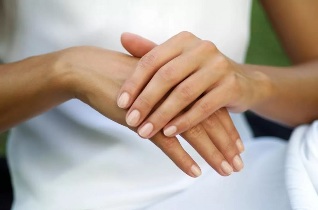
Psoriasis is a fairly common dermatological disease characterized by peeling and severe itching of the affected skin. There are many types of this disease. The most common types of psoriasis should be considered in detail, and these lesions can also be seen in the photo.
Causes of the disease
The disease is generally chronic. It develops for the following reasons:
- Weakening of the immune system. Abnormal immune processes lead to thickening of the skin, as a result of which the chronic form of the disease gradually begins to develop.
- Genetic predisposition. The likelihood of skin damage is quite high if at least one of the parents has suffered from psoriasis.
- Nervous disturbances and emotional upsets. This is one of the most serious factors in the development of this skin disease.
- Hormonal imbalance. Pathological changes in the endocrine system give an initial impetus to the appearance of the first signs of psoriasis.
- Disruption of metabolic processes in the body. This is due to the lack of vitamins and other nutrients.
- The presence of parasitic diseases. Toxic substances with which various types of helminths poison the human body can cause damage to the skin.
Modern medicine has not yet discovered the exact cause of this pathology.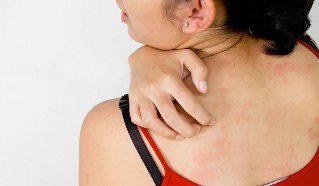 Very often, experts find the relationship between disorders of the immune system and psoriatic rashes.
Very often, experts find the relationship between disorders of the immune system and psoriatic rashes.
Symptoms of the disease
As already mentioned, there are many types of this dermatological disease. Depending on this, the patient may have different symptoms. The most common forms of psoriasis and their signs should be considered in more detail.
Psoriasis vulgaris
Represents the appearance of the plaques with white scales. The affected skin becomes inflamed and changes color. Such plaques gradually increase in size, the scales exfoliate over time. Psoriasis on the hands may not have scaly formations, especially on the folds. In these places, the skin turns red, severe itching and burning appear. Inguinal psoriasis develops the same way. Psoriasis vulgaris of the body can affect most of the skin.
Psoriasis tear
This form of the disease received its name due to the teardrop shape of convex psoriatic rashes. They have a purplish red hue. Teardrop-shaped neoplasms usually spread to the back, abdomen and affect almost any part of the body. They cause severe itching, especially during periods of exacerbation.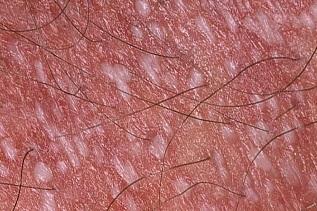 Most often, this form of the disease develops due to infectious diseases.
Most often, this form of the disease develops due to infectious diseases.
Pustular psoriasis: photo
This type of psoriasis is the appearance of small growths filled with clear fluid. The skin around these particular pimples becomes inflamed and bright red. It is subject to rapid peeling, which causes painful sensations. Often this form of the disease manifests itself on the nails. The appearance of pustular psoriasis can be seen in the photo.
Arthropathic psoriasis
It develops gradually, the initial stage of this disease can pass without any symptoms. Joint and muscle tissues are damaged. As the patient develops, he begins to experience unpleasant sensations in the area of the affected joints, stiffness of movements is observed, especially after waking up. The skin in the affected area becomes inflamed and has a red color. The joints of the upper and lower limbs are most often affected by psoriatic osteoarthritis.
Palmar-plantar psoriasis
This is a fairly common form of the disease. It is characterized by damage to the palms and soles of the feet. In these places, solid foci appear with well-defined edges. The constant dryness and peeling of the skin can lead to cracks. In such situations, extreme care should be taken, as infection of the resulting wounds may occur. 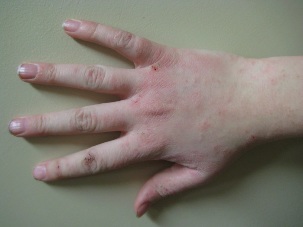 The skin in the affected area becomes hard and rough.
The skin in the affected area becomes hard and rough.
Premature psoriasis: photo
How does the development of this pathology begin? This disease in the initial stage can be asymptomatic. Small pinkish plaques usually appear. The surface of the skin on them is still smooth and shiny. After a couple of days, the plaques become covered with small scales, the itching in the affected areas begins to bother. These scales easily move away from the plaques, under them the skin looks inflamed. This process is called punctate psoriasis.
Psoriasis in children
This disease can also occur in newborns. It is always accompanied by painful sensations in the affected areas, after which severe itching appears. The formed plaques most often crack, minor bleeding begins to occur. This process is called capillary psoriasis. The danger of the form lies in the possible infection of the wounds formed in the child.
Psoriasis on the head: photo
It is not uncommon to find damage to the scalp with this disorder. With an advanced form of such a lesion, the hair falls out and stops growing. The localization of the foci can be observed in such points on the head:
- psoriasis behind the ears;
- in the occipital region and on the forehead;
- psoriasis on the neck;
- on the scalp.
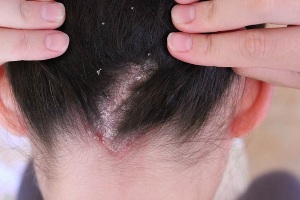
A head condition is usually accompanied by the following symptoms:
- slight scaling with itching and irritation;
- inflammation in the affected area;
- scratching sore spots causes damage;
- the skin gradually becomes rougher and thicker;
- dandruff on the scalp;
- the skin is very susceptible to severe trauma;
- itching increases every day.
Advanced psoriasis - photo
An advanced form of the disease can lead to dangerous consequences. In addition to psoriatic osteoarthritis, a person can develop the following pathologies:
- dysfunction of the heart and blood vessels;
- ischemic disease;
- stroke;
- cardiac arrhythmia.
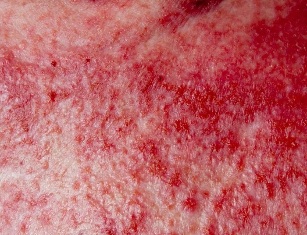
The patient begins to feel such disturbances:
- inflamed skin is purple in color;
- general weakness of the body;
- increase in body temperature;
- heart palpitations;
- poor appetite until its complete loss;
- weakness in muscles and joints.
With an advanced form of the disease, a significant area of the skin is affected. The patient experiences constant weakness and fatigue. Therefore, it is very important to start treatment early.
Consequences of the disease
It is no secret that psoriatic rashes significantly impair the quality of daily life. The person concerned may have the following psychophysiological problems:
- fear of playing sports;
- the need to constantly hide your illness;
- self-confidence gradually disappears;
- development of a chronic depressive state;
- problems with the opposite sex, a person begins to avoid intimacy with a loved one.
Moreover, in some cases, this pathology negatively affects the choice of a person's professional activity.
Therefore, the disease has a negative impact not only on physical health, but also on the psycho-emotional state. At the first signs of psoriasis, you need to contact a specialist for help. He will prescribe the most effective treatment, help get rid of the rash as soon as possible.
























